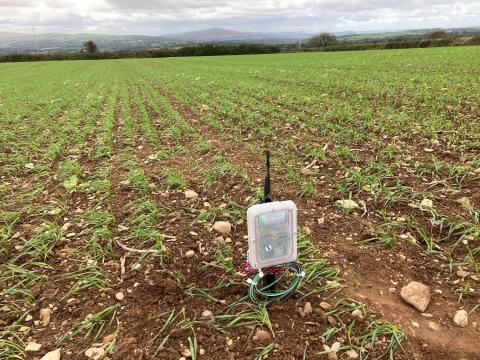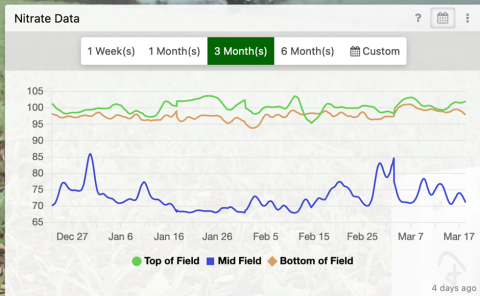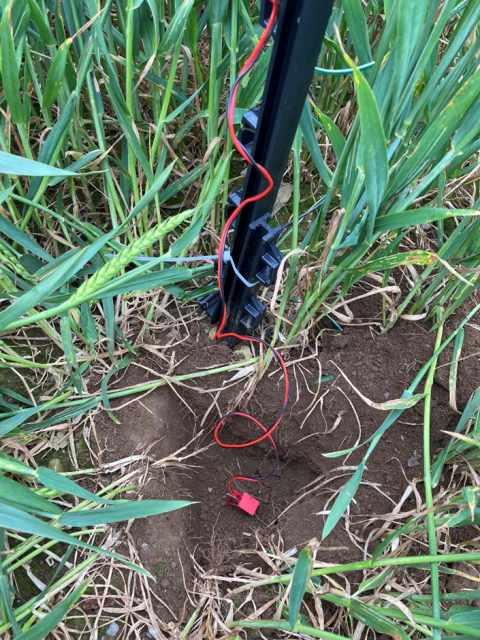Pantyderi Project Report: Using LoRaWAN connectivity to monitor real time soil nitrate levels in a winter wheat crop
Site: Pantyderi
Technical Officer: Dr Delana Davies
Project Title: Using LoRaWAN connectivity to monitor real time soil nitrate levels in a winter wheat crop
Aims of the project
- To explore the use of the existing LoRaWAN gateway at Pantyderi demonstration site to collect and monitor real time soil nitrate readings. The project collaborated with an Innovate UK project developing the use of soil nitrate sensors and based at the John Innes Centre in Norwich.
- To build a database of information on real time levels of soil nitrate and their changes over time relative to soil temperature, rainfall, crop growth and development, thereby enhancing knowledge on potential measures to increase efficiency of nitrogen use in the growing crop.
What was done
The trial field was an 8 hectare (ha) field sown with winter wheat that had previously grown a bi-crop of peas and beans. Being a pulse crop, this crop supports nitrogen fixing nodules on its roots, which have a symbiotic relationship with the host plant deriving carbohydrate from it and supplying nitrogen in return. No nitrogen fertiliser was used to grow the peas and beans and any residual nitrogen will be left in the soil for use by the winter wheat crop.
Three sets of nitrate sensors, together with temperature and moisture sensors, were installed at the top, middle and bottom of the field at 15cm soil depth and connected to a LoRaWAN transmitter. Data recording continued from the end of October through to crop harvest in July.
Figure 1: Set of soil nitrate, temperature and moisture sensors with LoRaWAN transmitter
LoRaWAN connectivity
Initial siting of the LoRaWAN gateway was on the side wall of a building on the farmyard but the signal was compromised by not having a direct line of sight with the sensor field. The gateway was moved to the gable end of the building, clearing the roof line, which improved signal strength measurably.
With gateway connection to the internet, it was possible to share the data collected in real time with all actors involved and a dashboard app was developed for the farmer to view real time readings on his mobile phone. This proved much more convenient than the previous use by the Innovate UK project of a laptop taken to the field to download the data logger readings.
Initial placement of the field transmitter was close to the ground which helped withstand the stormy weather of February, but as the crop developed in spring, signal strength became weaker once enveloped by the crop and the three transmitters needed to be lifted on longer posts to above crop height.
Soil nitrate sensor readings
Following placement, the nitrate sensors showed readings two to three times higher than expected for normal soil basal levels and this was assumed to represent the available nitrogen fixed by the previous bi-crop of peas and beans. Advice given by Prof. Tony Miller was to wait until nitrate levels dropped by 20% before applying nitrogen fertiliser, but there was no evidence of this occurring over the winter period (figure 2).
Figure 2: Nitrate sensor readings from December to March
A 25% nitrogen fertiliser with 5% sulphur was applied at the end of March at the rate of 150kg/ha, although no significant response was recorded by the sensors. Soil and leaf samples were tested for nitrogen in April and crop leaf nitrogen was found to be adequate. Soil extracted nitrogen measurements are not an exact match with nitrate sensor outputs as soil water nitrate is the closest approximation to the values reported by the nitrate sensors. However, SMN (Soil Mineral Nitrogen) in the soil profile was low, indicating that the crop had used up all available nitrogen.
Following the lack of response seen by the nitrate sensors on applying nitrogen fertiliser, it was suggested by the project team that they should be dug up and replaced, and the old sensors were returned for calibration. On testing, the old sensors showed poor sensitivity to nitrate, particularly in the lower concentrations where finer changes are detected, which confirmed suspicion that they deteriorate over time and have a soil life of no more than 4-5 months.
Figure 3: Replacing the nitrate sensors on 26 May
Soil temperature and moisture readings
The ability to collect data every two hours on soil characteristics at 15cm depth provided a valuable insight into this exposed field at 230m above sea level. Soil temperatures of 6-7ºC are required for nitrogen mineralisation and uptake, coinciding with increased soil biological activity and plant growth, and this was not recorded consistently until mid-April.
Soil moisture is also critical to nitrogen use efficiency and soils began to dry out in mid-March and continued in this vein all summer. Later nitrogen applications were therefore made by foliar spray highlighting that soil moisture sensors at plant root depth may be beneficial in delivering information to ensure the best outcome for this expensive input.
Conclusions
LoRaWAN connectivity has worked well to collect and transmit large volumes of real time data and the Innovate UK project team are encouraged enough by the results to investigate this application further in their work.
The use of nitrate sensors can provide valuable insight into how water-soluble nitrate levels are changing in the soil at plant root depth with the potential to increase nitrogen use efficiency. The sensors used were laboratory developed and calibrated and obviously need more attention to develop their robustness under field conditions.
The winter wheat crop yielded 9.7t/ha and YEN Grain Nutrient Benchmarking results showed that the crop was not deficient in nitrogen despite receiving around 50% less applied nitrogen than the normal crop recommended level.
Soil temperature and moisture sensors are cheap to deploy, and together with automatic collection of data using a LoRaWAN gateway, have the potential to provide farmers with specific knowledge that can improve timing and quantities of nitrogen application for a particular field. It may also help provide indication of conditions where foliar nitrogen application would give a better outcome than soil application in a moisture deficient situation.



